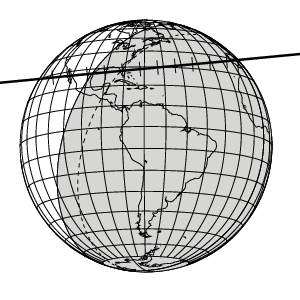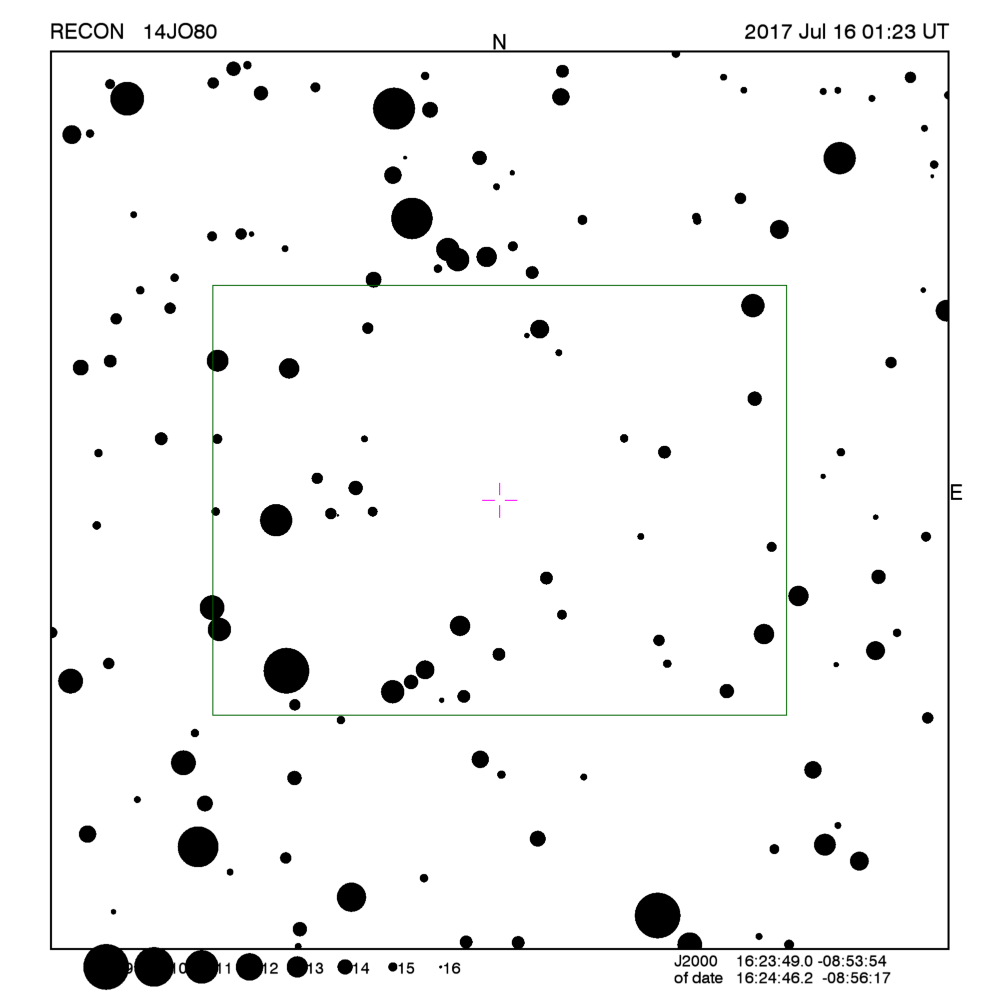RECON: TNO occultation with 14JO80
Event between 14JO80 and star UC4-406-065955
with event index number of 136410
Geocentric closest approach at 2017/07/16 01:24:06 UTC
J2000 position of star is 16:23:49.0 -08:53:54
Equinox of date position of star is 16:24:44.2 -08:56:11
Stellar brightness R=16.0
Star is 128 degrees from the moon.
Moon is 58% illuminated.
TNO apparent brightness V=22.7
 TNO is 32.0 AU from the Sun
and 31.3 AU from the Earth.
TNO is 32.0 AU from the Sun
and 31.3 AU from the Earth.
The TNO is moving 14.6
km/sec on the sky relative to the star, or,
2.3 arcsec/hr.
The 1-sigma error in the time of the event is 1373 seconds.
The 1-sigma cross-track error in the shadow position is
1583 km.
The TNO has an absolute magnitude Hv=7.5
Diameter=189.7 km assuming a 5% albedo -- 13.0 sec chord
Diameter=77.4 km assuming a 30% albedo -- 5.3 sec chord
Dynamical classification is 3:2E
Star training set for 14JO80, (2017/07/16 01:24UT)
Object RA Dec mag sep mel
Antares 16:30:29.1 -26:28:10 0.9 17.58 124
13Zet Oph 16:38:07.6 -10:36:05 2.6 3.69 125
3Ups Oph 16:28:45.2 -08:24:35 4.2 1.12 128
PPM 199584 16:23:14.6 -08:46:55 7.9 0.41 129
PPM 199606 16:24:20.6 -09:01:21 8.6 0.14 129
14JO80 16:24:46.2 -08:56:17 16.0 128
Positions are for equinox of date

Azimuth is measured in degrees eastward from north.
North is at an azimuth of 0, due East is at an azimuth
of 90 degrees, due South is 180, and due West is 270.
Do not use the listing below for the RECON CPC 1100 telescopes.
This is provided for other non-team facilities.
Star training set for 14JO80, (2017/07/16 01:24UT)
Object RA Dec mag sep mel
Antares 16:29:24.4 -26:25:55 0.9 17.58 124
13Zet Oph 16:37:09.6 -10:34:01 2.6 3.69 125
3Ups Oph 16:27:48.1 -08:22:18 4.2 1.12 128
PPM 199584 16:22:17.4 -08:44:30 7.9 0.41 129
PPM 199606 16:23:23.3 -08:58:58 8.6 0.14 129
14JO80 16:23:49.0 -08:53:54 16.0 128
Positions are for J2000
Event circumstances last updated at 2016/11/30 19:09:28 UT
Marc W. Buie,
Southwest Research Institute
RECON
 TNO is 32.0 AU from the Sun
and 31.3 AU from the Earth.
TNO is 32.0 AU from the Sun
and 31.3 AU from the Earth.
